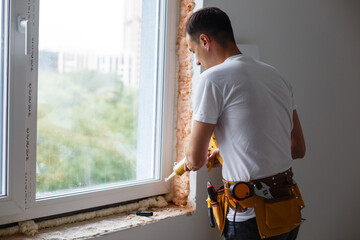Windows play an essential role in every home, providing natural light, ventilation, and insulation. However, over time, windows may develop issues such as cracks, drafts, or faulty mechanisms. Learning how to fix a window can save money, increase energy efficiency, and extend the life of your property. While some problems may require professional help, many common issues can be handled with a little patience and the right approach.

Why Fixing a Window Matters
A damaged window is more than just an inconvenience. Cracked glass, loose frames, or worn-out seals can affect comfort, safety, and energy bills. For example, a window that does not close properly may allow drafts, increasing heating or cooling costs. Cracks in the glass can weaken the structure, posing safety risks. Addressing window problems early helps maintain security, improve insulation, and prevent further damage.
Common Window Problems
Before learning how to fix a window, it helps to recognize common issues homeowners face:
- Cracked or Broken Glass – One of the most visible issues that compromises safety and efficiency.
- Drafts and Leaks – Caused by worn weatherstripping, gaps, or damaged seals.
- Stuck Windows – Dust, dirt, or warped frames can make windows difficult to open or close.
- Foggy Glass – Moisture trapped between panes of double-glazed windows indicates seal failure.
- Loose or Damaged Frames – Over time, frames may shift, crack, or separate from walls.
Understanding the problem allows you to choose the right repair method and avoid unnecessary expenses.
Tools and Materials You May Need
Fixing a window often requires basic tools that many households already have. While the exact list depends on the issue, common supplies include:
- Screwdrivers
- Putty knife
- Utility knife
- Measuring tape
- Replacement glass or glazing compound
- Weatherstripping material
- Sandpaper
- Caulk and sealant
Having the proper tools ready ensures smoother repairs and better results.
How to Fix a Cracked or Broken Window
Broken glass is one of the most urgent window problems. Here’s a step-by-step process to handle it safely:
- Remove the Broken Glass
- Wear protective gloves and carefully take out the damaged glass. Dispose of it safely to prevent injury.
- Prepare the Frame
- Clean the window frame, removing old putty or glazing points with a putty knife. Ensure the surface is smooth for proper installation.
- Measure and Cut Replacement Glass
- Measure the frame precisely. Cut or order replacement glass to fit slightly smaller than the opening.
- Install the New Glass
- Place the glass into the frame and secure it with glazing points. Apply fresh glazing compound around the edges to seal it.
- Allow to Cure
- Let the glazing compound dry fully before painting or touching the repaired window.
This method restores safety and efficiency while avoiding the cost of full window replacement.
Fixing Drafts and Leaks
Drafts are a common problem that wastes energy and reduces comfort. To fix them:
- Inspect Seals and Weatherstripping
- Check for gaps around the frame, sash, or glass edges.
- Apply Weatherstripping
- Add new weatherstripping to create a tight seal. Adhesive-backed strips are easy to install and highly effective.
- Use Caulk
- Apply caulk to seal cracks or gaps around the frame and exterior trim.
- Check Window Locks
- Ensure the window locks properly to press the sash tightly against the frame.
By fixing drafts, you improve insulation, lower utility costs, and enhance indoor comfort.
Repairing Stuck Windows
Windows that won’t open or close properly are frustrating. To fix this issue:
- Clean the Tracks
- Dirt and debris often block window tracks. Use a vacuum or brush to remove buildup.
- Lubricate Moving Parts
- Apply a silicone-based lubricant to tracks and hinges for smoother operation.
- Sand and Adjust
- If wooden frames swell or warp, lightly sand them down to restore movement.
- Check Balance Mechanisms
- On sash windows, worn or broken balances may prevent smooth movement. Replacing these parts can restore functionality.
Handling Foggy Windows
Double-pane windows may fog due to broken seals. While fixing the seal itself can be challenging, there are temporary solutions:
- Use Dehumidifiers – Reduce indoor moisture to minimize fogging.
- Ventilate the Area – Improve airflow around the window.
- Professional Replacement – If fogging persists, replacing the glass unit may be the best long-term fix.
Strengthening Loose Window Frames
Window frames may loosen with age, leading to air leaks and structural issues. To fix them:
- Tighten Screws and Fasteners
- Inspect hinges, locks, and screws, tightening them where necessary.
- Apply Wood Filler or Sealant
- For small cracks, use filler or caulk to strengthen the frame.
- Reinforce with Trim
- Installing new interior or exterior trim helps stabilize older frames.
Preventing Future Window Problems
Fixing a window is only half the battle—prevention is equally important. Here are some maintenance tips:
- Clean windows and tracks regularly.
- Inspect seals and caulking every season.
- Repaint wooden frames to protect against moisture.
- Lubricate hinges and locks annually.
- Address small cracks or gaps before they worsen.
Consistent care extends the lifespan of your windows and reduces the need for major repairs.
Knowing how to fix a window is a valuable skill that saves money, improves home efficiency, and enhances safety. From repairing broken glass to sealing drafts and freeing stuck sashes, many window problems can be solved with simple tools and techniques. Regular maintenance not only prevents costly damage but also ensures your windows remain functional and attractive for years.
By addressing issues quickly and taking proactive steps, homeowners can keep their windows in excellent condition while maintaining a comfortable and energy-efficient living space.